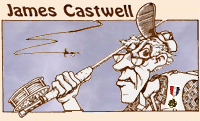|
Walk down to him.
Let me start out this way. WALK DOWN TO HIM!
There, I've been wanting to write that for seven
years. Time after time I see it on T.V. and on the
stream; a guy standing knee-deep facing down-stream,
rod bent, slack-jawed and frantic. Somehow he got
a fish and now it's downstream from him and he
stands trapped in his tracks, cranking his large-arbor
reel. What's the matter, Dorf, you too lazy to move
a little?
First off, when a fish is downstream from you he
isn't using up any energy. The current is doing
his work for him. A little wiggle sideways and he
can tack and plane wherever he wants to go. Meantime,
your fly is wearing a bigger and bigger hole in his
lip, time is on his side. And, by the way, if you
really want to increase your landing ratio, try to
hook as many as possible upstream, not down. The
fly has a far better chance of getting into the
hinge of the jaw.
Let me quote from a book written about forty years
back by Harold Walden 2nd, called The Last
Pool. Here a story about a guy who has been
swinging big streamers at night on a fair sized
stream out east; the fish has just hit it on the
swing.
"Now it starts. Now that reverie has left you
and you are caught up full in the ecstacy of high
strife. There is a moment now when your reel gives
out a sound you have never heard it make. Yard after
yard of precious line is leaving your guides, entering
the water in this mad charge.
Let it go for an instant. Then check, not abruptly
but slowly, feeling his weight. You know how much
line you have, including your backing; you know the
approximate length of line when the strike occurred.
The difference is your margin of safety–or part of
it. The rest is hidden in the bed of the stream:
rocks and roots and snags, a run of rough water
below, and if he gets into any of these he is lost.
Then keep him away. Keep him in open water if you
can and say a prayer for your tackle as you prepare
to turn him. For you've got to turn him now. You
can't let him get snagged or reach the end of your
line at full speed.
Now apply pressure. Something less than the breaking
point usually suffices to turn any but the largest
fish.
Does he come around? Is he doesn't, hold him where
he is with an even pressure or let him go a little
farther if you dare. If he is downstream, WADE DOWN
TO HIM, keeping the line tight. But don't try to
horse him back; a lost fish will be the almost certain
result."
The caps above are mine, but I wanted to make sure
you didn't miss that line. The fish will most often
hold still if you do not 'gig' him up while you are
making your way downstream to get at least alongside
of him. Now, pop him a bit, be careful though, he
has been resting and will now probably run against
the strain of your line. That would likely be
upstream at this point.
From here on out you are in command. Play him as
you should and when he has wearied of the game,
let him drift back into your awaiting net. I have
even been known to let up and allow a few feet of
slack to happen when I get alongside of a nice fish
in a stream. The current will take the line downstream
and he has hardly any choice as to which way to run.
No real slack develops as the stream keeps the line
tight. Sneaky, but I still has a few tricks up my
sleeve.
Want another one? Do not be in a big hurry to net
your fish. Likely as not you are going to release
him anyway, so, relax. If he has any size he will
make another run about the time is close enough
to read Hodgman and off he goes again. Be ready
for it. Keep your rod just above horizontal, short
line, in front of you. When he takes off he is on
the reel and you are still in control. Net him on
the next pass when both of you have settled down
somewhat.
Then you both will deserve each other. ~ James Castwell
|



